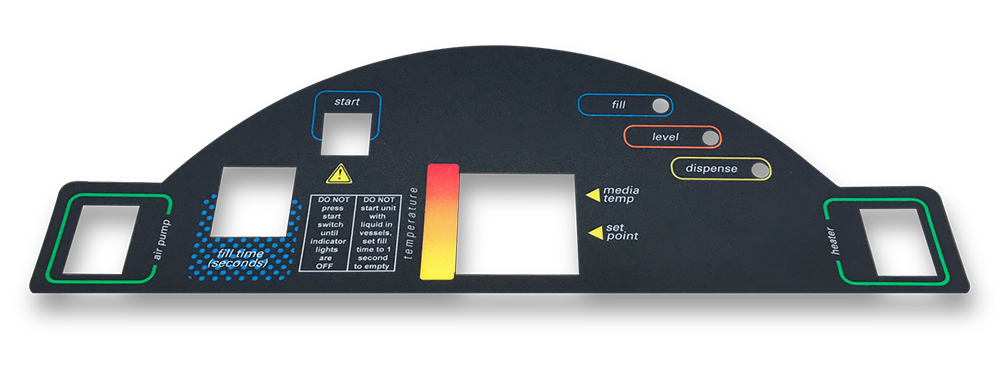Why Top-Tier Graphic Overlays Are Crucial for Commercial Equipment
Why Top-Tier Graphic Overlays Are Crucial for Commercial Equipment
Blog Article
Understanding How Graphic Overlays Job to Improve Your Creative Tasks
Graphic overlays offer as a critical element in the world of imaginative tasks, enhancing both visual interaction and target market involvement. The effective integration of these overlays needs cautious factor to consider of layout concepts and objectives.
What Are Graphic Overlays?
Graphic overlays are visual components that are positioned on top of a base image or user interface to enhance communication and user experience. They serve various purposes, including providing additional details, leading customer interaction, and enhancing aesthetic allure. Typical applications of graphic overlays can be found in digital interfaces, marketing, and academic materials.

Graphic overlays are commonly produced making use of design software, enabling designers to control shade, size, and transparency to accomplish the desired impact. They can be static or dynamic, with animations that attract the audience's eye and boost interaction. The tactical usage of visuals overlays not only enhances aesthetic hierarchy however also help in delivering a clear and meaningful message. As such, comprehending exactly how to efficiently apply graphic overlays is important for designers aiming to raise their creative jobs.

Benefits of Using Graphic Overlays
Making use of graphic overlays can substantially improve the efficiency of aesthetic interaction throughout various tools. Among the main benefits is the ability to share intricate info succinctly. By layering graphics, text, and photos, overlays assist in the discussion of information in a more absorbable format, making it simpler for target markets to grasp vital ideas quickly.
Moreover, graphic overlays can improve visual charm, accentuating particular elements within a style. This is specifically helpful in marketing and advertising, where catching the audience's passion is critical. The critical use of shades, shapes, and typography in overlays can develop a interesting and cohesive visual story, improving brand acknowledgment.
Additionally, graphic overlays supply adaptability in design. They enable makers to adapt web content for different platforms without going back to square one, guaranteeing uniformity across different networks. This flexibility is important in today's electronic landscape, where content should be enhanced for varied gadgets and layouts.
Kinds of Graphic Overlays
When thinking about the different sorts of visuals overlays, it is necessary to identify their diverse applications across different industries. Graphic overlays can be categorized primarily into three kinds: useful, attractive, and educational.
Functional overlays anonymous are created to improve the use of an item. Commonly located in electronic gadgets, these overlays usually give responsive comments through elevated switches or distinctive surface areas, enhancing user communication. They can also serve as a safety layer, safeguarding the underlying components from wear and tear.
Decorative overlays concentrate on visual enhancement, allowing brand names to share their identity through vibrant designs and customized graphics. These overlays are common in packaging, advertising, and point-of-sale products, where visual charm is critical for bring in clients.
Informational overlays, on the various other hand, are utilized to share crucial data or guidelines. They can be seen in applications such as signs, user handbooks, and training graphics, where quality and readability are vital.
Each sort of visuals overlay serves an one-of-a-kind objective, contributing to the total efficiency of creative tasks while resolving certain needs within different industries. Recognizing these distinctions is crucial for selecting the right overlay for your job.
Best Practices for Application
To ensure the successful implementation of graphic overlays, it is critical to develop a clear understanding of the project's purposes and the details needs of the end-users. Begin by performing detailed research to determine the target audience and their preferences, as this will inform design options and performance.
Next, create an in-depth plan that lays out the overlay's purpose, format, and assimilation process. This plan needs to include interface considerations, making certain that overlays improve as opposed to block the customer experience - Graphic Overlays. Preserve and consider the aesthetic hierarchy uniformity in layout elements, such as color typefaces, symbols, and plans, to advertise brand comprehensibility
Examining is blog here necessary; gather responses from a depictive example of individuals to recognize potential concerns and locations for enhancement. Iterate on the design based on individual input and efficiency data. Furthermore, guarantee compatibility throughout various gadgets and systems to take full advantage of accessibility.
Tools for Developing Overlays
Creating efficient visuals overlays requires the right tools to equate layout concepts right into functional applications. Different software program and systems are available, each tailored to particular needs and ability degrees.
Adobe Photoshop and Illustrator are sector standards, providing considerable capabilities for producing and controling overlays. These devices supply sophisticated functions such as layer administration, mixing modes, and vector graphics, allowing designers to produce detailed and premium overlays.
For those looking for an extra straightforward technique, Canva and Figma are excellent choices (Graphic Overlays). Canva's intuitive interface permits users to develop overlays quickly utilizing pre-designed templates, while Figma facilitates collective design in real-time, making it optimal for teams
Additionally, open-source choices like GIMP and Inkscape give durable functionalities without the associated prices of exclusive software. These tools enable versatility in style and can accommodate numerous data styles, ensuring compatibility throughout different systems.

Final Thought
In verdict, graphic overlays Full Article serve as effective tools for improving imaginative projects by supplying aesthetic clarity, visual appeal, and brand uniformity. By understanding the fundamental principles and benefits associated with visuals overlays, makers can dramatically improve the high quality and efficiency of their aesthetic communications.
Graphic overlays serve as a crucial part in the world of creative jobs, boosting both visual interaction and audience engagement.Graphic overlays are often produced making use of style software, allowing designers to adjust shade, size, and openness to attain the preferred impact.Furthermore, graphic overlays can enhance visual appeal, attracting interest to certain aspects within a design.In addition, graphic overlays offer adaptability in layout.In final thought, graphic overlays offer as effective tools for improving creative jobs by supplying aesthetic clearness, aesthetic allure, and brand name consistency.
Report this page